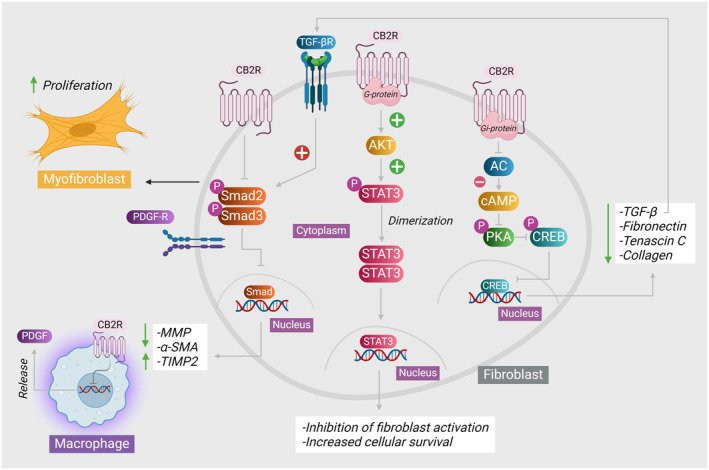FIGURE 1.

The protective effects of CB2 receptors on fibroblasts. Upon the activation of CB2 receptors following the binding of CB2 agonists, several intracellular pathways can be initiated. As CB2 receptor is a GPCR bound to Gi subunit this leads to the inhibition of AC that in turn leads to a decrease in the intracellular concentration of cyclic adenosine monophosphate (cAMP). Decreased cAMP inhibited the activation and phosphorylation of PKA which in turn inhibits the phosphorylation and nuclear translocation of CREB transcription factor which ultimately inhibits the gene expression of fibrogenic proteins including tumor growth factor‐beta (TGF‐β), fibronectin, collagen, and tenascin C. The decreased production of TGF‐β results in decreased activation of TGF‐βR that positively acts on transducing Smad2 and Smad3 signaling and producing TIMP2 and α‐SMA, and decreased matrix metalloproteinase release. CB2 receptor also directly inhibit the action of Smad2 and Smad3 transcription factors. Besides, CB2 receptor activation increases activation of AKT, which in turn phosphorylates STAT3 transcription factor. Upon phosphorylation, STAT3 induces transcription of protective genes enhancing cellular survival. A side illustration of CB2 receptor expression on macrophages and the ultimate effect of inhibited PDGF production following CB2 receptor activation. AC, adenylyl cyclase; AKT, protein kinase B; cAMP, adenosine 3′;5′‐cyclic monophosphate; CREB, cAMP response element‐binding protein; PDGF, platelet‐derived growth factor; PKA, protein kinase A; Smad, suppressor of mothers against decapentaplegic; STAT3, signal transducer and activator of transcription 3.
